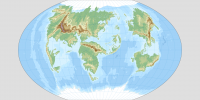Aravala
{{Infobox planet
| name = Aravala
| alt_names = Earth, World, Maa, Maapallo, Daellak
| adjectives = Aravalanian
| symbol = ![]() | image = File:Aravala globe.png
| image_alt = Drawing of Aravala, after the famous picture by SNTL Cosmonauts in 1975 Showing the Centrall Archipelago in the middle and the Old Continent on the left, and the Newland in the far right.
| caption = The most widely used photograph of Earth, taken by SNTL Cosmonauts in 1975
| epoch =
| aphelion = 152,100,000 km
| perihelion = 147,095,000 km
| time_periastron = 2021-Jan-02 13:59
| semimajor = 149,598,023 km
| eccentricity = 0.0167086
| period = 365.256363004 d
| avg_speed = 29.78 km/s
| mean_anomaly = 358.617°
| inclination = 7.155 ° to the Sun 's equator ; 1.57869 ° to invariable plane ; 0.00005° to J2000
| asc_node = -11.26064 ° to J2000 ecliptic
| arg_peri = 114.20783 °
| satellites =
| image = File:Aravala globe.png
| image_alt = Drawing of Aravala, after the famous picture by SNTL Cosmonauts in 1975 Showing the Centrall Archipelago in the middle and the Old Continent on the left, and the Newland in the far right.
| caption = The most widely used photograph of Earth, taken by SNTL Cosmonauts in 1975
| epoch =
| aphelion = 152,100,000 km
| perihelion = 147,095,000 km
| time_periastron = 2021-Jan-02 13:59
| semimajor = 149,598,023 km
| eccentricity = 0.0167086
| period = 365.256363004 d
| avg_speed = 29.78 km/s
| mean_anomaly = 358.617°
| inclination = 7.155 ° to the Sun 's equator ; 1.57869 ° to invariable plane ; 0.00005° to J2000
| asc_node = -11.26064 ° to J2000 ecliptic
| arg_peri = 114.20783 °
| satellites =
- 1 natural satellite: the Moon
- 5 quasi-satellite s
- >3 300 operational artificial satellite
- >18 000 tracked space debris
| allsatellites = yes | mean_radius = 6371.0 km | equatorial_radius = 6378.137 km | polar_radius = 6356.752 km | flattening = 1/ 298.257222101 VMplRS93 | circumference =
- 40075.017 km
- 40007.86 km
| surface_area =
- 510067420 km2
- n/n km2 Land
- n/n km2 water
| volume = 1.08321 e=12km3 | mass = 5.97237 e=24kg | density = 5.514 g/cm3 | surface_grav = 9.80665 m/s2 | moment_of_inertia_factor = 0.3307 | escape_velocity = 11.186 km/s | sidereal_day = 0.99726968 d | rot_velocity = 1674.4 km/h | axial_tilt = 23.4392811° | albedo = 0.367 Geometric albedo |0.306 Bond albedo | atmosphere = yes | temp_name1 = Celsius | min_temp_1 = −89.2 °C | mean_temp_1 = 14 °C (1961–90) | max_temp_1 = 56.7 °C | temp_name2 = Fahrenheit | min_temp_2 = −128.5 °F | mean_temp_2 = 57.2 °F (1961–90) | max_temp_2 = 134.0 °F | surface_pressure = 101.325 kPa (at Sea level) | atmosphere_composition =
{{unbulleted list |class=nowrap
| 78.08% nitrogen (Template:Chem2; dry air)
| 20.95% oxygen (Template:Chem2)
| ~ 1% water vapor] (climate variable)
| 0.9340% argon
| 0.0413% carbon dioxide
| 0.00182% neon
| 0.00052% helium
| 0.00019% methane
| 0.00011% [[krypton
| 0.00006% hydrogen
}}
| note = no }}
Etymology
The name Aravala Is not used as name for the Planet, but the local inhabitants call it simply as planet earth, or Maa , Maapallo In Evoan language. Aravala Is included as a name, to separate it from the world of the viewer. The Term Aravala appear in Evoan Religious concepts as Otherworldly afterlife, where the Gods and spirits dwells, and is in some sources described to include alternate worlds, therefore is been chosen to be used as the describing and Defining term when used in our world.
Geography
Main article: Geography of Aravala, Aravala
Map of Aravala
Map of Aravala shown in Winkel-Tripel projection.
The shape of Aravala is nearly spherical. There is a small flattening at the poles and equatorial bulge around the equator due to Aravala's rotation, therefore, a better approximation of Aravala's shape is an oblate spheroid, whose equatorial diameter is 43 kilometres (27 mi) larger than the Geographical pole-to-pole diameter.
The average diameter of the reference spheroid is 12,742 kilometres (7,918 mi). Local topography deviates from this idealized spheroid, although on a global scale these deviations are small compared to Aravala's radius: the maximum deviation of only 0.17% is at the Oipaal Trench (10,945 metres or 35,909 feet below local sea level), In geodesy, the exact shape that Aravala's oceans would adopt in the absence of land and perturbations such as tides and winds is called the geoid. More precisely, the geoid is the surface of gravitational equipotential at mean sea level are water deviations from MSL, analogous to land topography.
